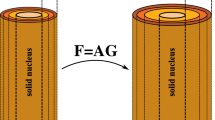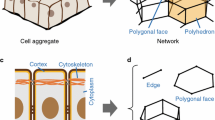Abstract
A set of equilibrium equations is derived for the stress-controlled shape change of cells due to the remodelling and growth of their internal architecture. The approach involves the decomposition of the deformation gradient into an active and a passive component; the former is allowed to include a growth process, while the latter is assumed to be hyperelastic and mass-preserving. The two components are coupled with a control function that provides the required feedback mechanism. The balance equations for general continua are derived and, using a variational approach, we deduce the equilibrium equations and study the effects of the control function on these equations. The results are applied to a truss system whose function is to simulate the cytoskeletal network constituted by myosin microfilaments and microtubules, which are found experimentally to control shape change in cells. Special attention is paid to the conditions that a thermodynamically consistent formulation should satisfy. The model is used to simulate the multicellular shape changes observed during ventral furrow invagination of the Drosophila melanogaster embryo. The results confirm that ventral furrow invagination can be achieved through stress control alone, without the need for other regulatory or signalling mechanisms. The model also reveals that the yolk plays a distinct role in the process, which is different to its role during invagination with externally imposed strains. In stress control, the incompressibility constraint of the yolk leads, via feedback, to the generation of a pressure in the ventral zone of the epithelium that eventually eases its rise and internalisation.
Similar content being viewed by others
References
Ambrosi D, Guana F (2007) Stress-modulated growth. Math Mech Solids 12: 319–342
Beloussov LV (1998) The dynamic architecture of a developing organism: an interdisciplinary approach to the development of organisms. Kluwer, Dordrecht
Beloussov LV, Saveliev SV, Naumidi II, Novoselov VV (1994) Mechanical stresses in embryonic tissues patterns morphogenetic, role and involvement in regulatory feedback. Int Rev Cytol 150: 1–34
Boyce MC, Arruda EM (2000) Constitutive models of rubber elasticity: constitutive models of rubber elasticity: a review. Rubber Chem Technol 73: 504–523
Brodland GW, I-Li Chen D, Veldhuis JH (2006) A cell-based constitutive model for embryonic epithelia and other aggregates of biological cells. Int J Plast 22: 965–995
Conte V, Muñoz JJ, Miodownik M (2008) 3D finite element model of ventral furrow invagination in the Drosophila melanogaster embryo. J Mech Behav Biomed Mater 2: 188–198
Costa M, Sweeton D, Wieschaus E (1993) The development of drosophila melanogaster. chap 8: gastrulation in drosophila: cellular mechanisms of morphogenetic movements. Cold Spring Laboratory Press
DiCarlo A, Quiligotti S (2002) Growth and balance. Mech Res Commun 29: 449–456
Epstein M, Maugin GA (2000) Thermomechanics of volumetric growth in thermomechanics of volumetric growth in uniform bodies. Int J Plast 16: 951–978
Eshelby JD (1951) The force on an elastic singularity. Philos Trans R Soc Lond A 6: 87–112
Garikipati K, Olberding JE, Narayanan H, Arruda EM, Grosh K, Calve S (2006) Biological remodelling: stationary energy, configurational change, variables and dissipation. J Mech Phys Solids 54: 1493–1515 arXiv:q-bio/0506023v2
Gonzalez O, Stuart AM (2008) A first course in continuum mechanics. Cambridge University Press, Cambridge
Gurtin ME (2000) Configurational forces as basic concepts of continuum physics. vol 137 of Appl Math Sci. Springer
Himpel G, Kuhl E, Menzel A, Steinmann P (2005) Computational modelling of isotropic multiplicative growth. Comput Model Eng Sci 8: 119–134
Holzapfel GA (2000) Nonlinear solid mechanics. A continuum approach for engineers. Wiley, New York
Humphrey JD (2001) Cardiovascular Solid Mechanics. Springer, Berlin
Ingber DE (1997) Tensegrity: the architectural basis of cellular mechanotransduction. Ann Rev Physiol 59: 575–599
Kienzler R, Herrmann G (2000) Mechanics in material space. Springer, New York
Kuhl E, Steinmann P (2003) On spatial and material settings of thermohyperelastodynamics for open systems. Acta Mech 160: 179–217
Kuhl E, Steinmann P (2004) Material forces in open systems mechanics. Comput Methods Appl Mech Eng 193: 2357–2381
Kuhl E, Garikipati K, Arruda EM, Grosh K (2005) Remodeling of biological tissue: mechanically induced reorientation of a transversely isotropic chain network. J Mech Phys Solids 53: 1552–1573
Kuhl E, Menzel A, Garikipati K (2006) On the convexity of transversely isotropic chain network models. Philos Mag 86: 3241–3258
Lubarda VA, Hoger A (2002) On the mechanics of solids with a on the mechanics of solids with a growing mass. Int J Solids Struct 39: 4627–4664
Lubarda VA (2004) Constitutive theories based on the multiplicative decomposition of deformation gradient: thermoelasticity, elastoplasticity, and biomechanics. Appl Mech Rev 57: 95–108
Maugin GA (1995) Material forces: concepts and applications. Appl Mech Rev 48(5): 213–245
Maugin GA, Berezovski A (2008) Introduction to the thermodynamics of configurational forces. Atti Accad. Pelorit. Peric LXXXVI(Supl. 1); doi:10.1478/C1S0801016
Miehe C, Göktepe S, Lulei F (2004) Progressive delamination using progressive delamination using interface elements. J Mech Phys Solids 52: 2617–2660
Mizuno D, Tardin C, Schmidt CF, MacKintosh FC (2007) Nonequilibrium mechanics of active cytoskeletal networks. Science 315: 370–373
Muñoz JJ, Barrett K, Miodownik M (2007) A deformation gradient decomposition method for the analysis of the morphogenesis. J Biomech, pp 1372–1380
Muñoz JJ, Conte V, Miodownik M (2009) Robust mechanisms of ventral furrow invagination require the shape changes. Phys Biol 6. doi:10.1088/1478-3975/6/1/016010
Odell GM, Oster G, Alberch P, Burnside B (1981) The mechanical basis of morphogenesis. I. Epithelial folding and invagination. Dev Biology 85: 446–462
Rajagopal KR, Srinivasa AR (2004) On the thermomechanics of materials on the thermomechanics of materials that have multiple natural and classical plasticity. J Appl Math Phys (ZAMP) 55: 861–893
Ramasubramanian A, Taber LA (2008) Computational modeling of morphogenesis regulated by mechanical feedback. Biomech Model Mechanobiol 7: 77–91
Rodriguez EK, Hoger A, McCulloch AD (1994) Stress-dependent finite growth in soft elastic tissues. J Biomech 27: 455–467
Simo JC (1985) A finite strain beam formulation. The three dimensional dynamic problem Part I. Comput Meth Appl Mech Eng 49: 55–70
Stamenović D, Ingber DE (2009) Tensegrity-guided self assembly: tensegrity-guided self assembly: from molecules to living cells. Soft Matter 5(6): 1137–1145
Steinmann P (2002) On spatial and material settings on spatial and material settings on thermo–hyperelastodynamics. J Elast 66: 109–157
Taber LA (1995) Biomechanics of growth, remodeling, and morphogenesis. Appl Mech Rev 48(8): 487–545
Taber LA (1998) A model for aortic growth based on shear fibre stresses. J Biomech Eng 120: 348–354
Taber LA (2008) Theoretical study of Beloussov’s hyper-restoration hypothesis for mechanical regulation of morphogenesis. Biomech Model Mechanobiol. doi:10.1007/s10237-007-0106-x
Author information
Authors and Affiliations
Corresponding author
Rights and permissions
About this article
Cite this article
Muñoz, J.J., Conte, V. & Miodownik, M. Stress-dependent morphogenesis: continuum mechanics and truss systems. Biomech Model Mechanobiol 9, 451–467 (2010). https://doi.org/10.1007/s10237-009-0187-9
Received:
Accepted:
Published:
Issue Date:
DOI: https://doi.org/10.1007/s10237-009-0187-9




